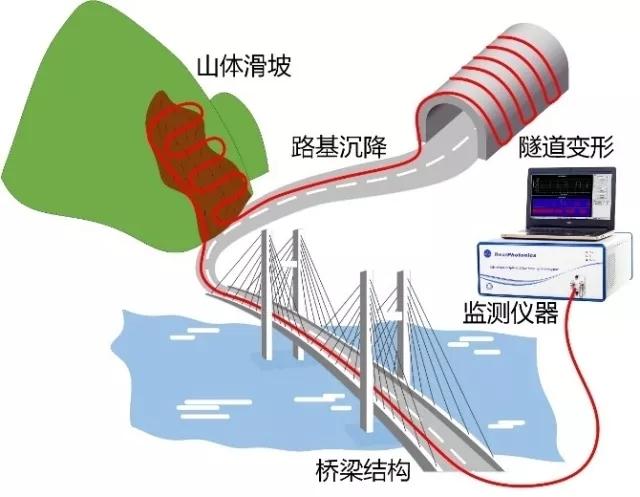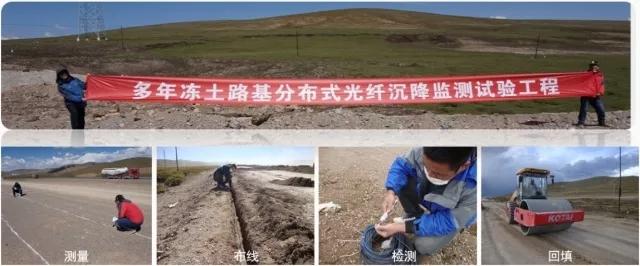发布日期:2017-11-24 查看:0
China's large infrastructure volume ranks at the forefront of the world, such as: Highway Bridges 780 thousand, railway bridges 70 thousand, are the world's first; highway mileage of more than 130 thousand kilometers, the world's first; oil and gas pipelines more than 120 thousand kilometers.
However, large infrastructure has been subjected to external forces and environmental erosion for a long time, which is likely to cause disasters, resulting in serious safety accidents and economic losses. At the same time, China is one of the countries prone to geological disasters in the world. Geological disasters have many types, wide area, high activity frequency and great harm degree. For example, in December 20, 2015, the debris landslide occurred in Shenzhen City, resulting in 74 deaths, direct economic losses of nearly 1 billion yuan.
In order to avoid casualties and reduce economic losses, large infrastructure and various geological disasters need to be monitored. However, large infrastructure, such as highways, tunnels, large bridges, oil and gas pipelines, power lines, and so on, has a long space and a wide distribution of geological disasters.
Point sensors based on resistance strain gages and fiber gratings can only measure limited discrete points, which can not be used to measure the whole space of the object to be measured (Fig. 1). The distributed Brillouin optical fiber sensor can be used for continuous measurement in space. It has the characteristics of long measuring distance and high positioning accuracy. The physical quantities include temperature and strain (Figure 2).


Compared with the traditional sensor technology, distributed optical fiber sensor has the advantages of light weight, resistance to harsh environment, anti electromagnetic interference, no electricity the common advantages of optical fiber sensor in the sensor, in addition, it can achieve up to millions of monitoring points and up to hundreds of kilometers long distance distributed measurement.
Applications include: oil and gas pipeline and storage tank temperature and deformation monitoring, monitoring of temperature and strain of submarine cable or terrestrial / cable, geological disasters (such as mountain landslide and mud rock flow etc) distributed monitoring, structural health monitoring of bridges, dams and tunnels and other large buildings, aircraft and spacecraft flight monitoring and fire alarm etc..
Distributed optical fiber sensing can be divided into Raman scattering, Rayleigh scattering and Brillouin scattering according to the scattering modes of light.
The distributed optical fiber sensing based on Raman scattering, Stokes and anti Stokes light intensity ratio is linear with temperature, and can be used for temperature measurement and fire alarm, but the sensing distance (~20 km) and spatial resolution (~1 m) are limited.
The distributed optical fiber sensing based on Rayleigh scattering is mainly used for optical fiber breakpoint and loss detection. In recent years, phase optical time domain reflectometer developed can realize distributed vibration measurement, which is mainly used in optical fiber perimeter security.
The distributed optical fiber sensor based on Brillouin scattering, scattering light and incident light frequency difference (Brillouin frequency shift) is linear with the fiber temperature and strain, using communication using single-mode optical fiber as sensor, can achieve long distance long (100 km), ultra high spatial resolution (CM) and high precision distributed strain and the temperature measurement, especially for large infrastructure and geological disasters mudslides and landslides monitoring.
Due to the limitation of 10 ns phonon lifetime, the traditional Brillouin optical fiber sensor has a low spatial resolution (about 1 m), which makes it unable to be applied to the high-end monitoring field with high spatial resolution.
To solve this problem, a differential pulse Brillouin optical time domain analysis (DPP-BOTDA) technique is proposed and developed, as shown in figure 3. This technique uses the pulse width is greater than the phonon lifetime of a couple of pulse differential analysis, effectively overcome the traditional narrow pulse causes the degradation of a signal-to-noise ratio and spectral broadening, break the limit of traditional life of phonon Brillouin sensing in spatial resolution, the high spatial resolution of 2 cm.
Based on the DPP-BOTDA structure, we propose to suppress the modulation instability using a new type of negative dispersion fiber, and the frequency division multiplexing and space division multiplexing technology to reduce the segmentation measurement, pumping effect of pulsed light transport, which succeeded in sensing distance significantly improved to 150 km.

In order to verify the spatial resolution of the system, we have measured the strain distribution of a strain of 2 cm, 5 cm, 10 cm, 20 cm and 30 cm (fused with different fibers to simulate strain) for a length of 3.2 m single-mode fiber, as shown in figure 4. The measurement results clearly and accurately reflect the length of different strain areas, and the three-dimensional signal is more intuitive, which reflects the one-to-one correspondence between the measured results and the actual strain region.


High performance distributed Brillouin fiber sensing apparatus of Harbin Institute of Technology professor Dong Yongkang research group and Anshan Freetech Photoelectric Technology Co Ltd (new product is shown in Figure 5), the working principle based on DPP-BOTDA, can realize the long distance, high spatial resolution and high accuracy of the distributed optical fiber temperature and strain sensing, its advantage lies in:
Spatial resolution: 2 cm
Sensing distance: 100 km
Measurement of physical quantities: strain and temperature
Strain accuracy: 10 UG
Temperature accuracy: 0.5
Measuring time: 2 seconds to several minutes

Application case 1: Haicang Bridge in Xiamen
In order to meet the great demand of large bridge structure safety diagnosis and evaluation, in the National 863 project "large bridge space distributed monitoring and safety evaluation of diagnostic technology" project support, we carried out a large suspension bridge based on distributed Brillouin optical fiber sensing technique for structural health monitoring research.
The object of this project is Haicang Bridge in Xiamen. It is the first three span continuous floating steel box girder suspension bridge in Asia and the world's second (second only to Denmark). As of 2015, Haicang Bridge has been in service for 15 years, ensuring its structural safety is the most important condition for continued service.
In order to test the working state and use capacity of the bridge structure, the load bearing test and linear measurement were carried out in November 2015, and the safety degree of the bridge structure was tested.
The bridge is the research group of independent research and development of distributed Brillouin optical fiber sensing analyzer for various operating conditions of the whole strain distribution was measured successfully obtained kilometer long span suspension bridge full scale continuous strain distribution results, can accurately determine the position information of vehicle load and bridge strain distribution caused by the load, and provide a strong basis for the bridge safety assessment.

Case two: Qinghai Tibet Expressway
The Qinghai Tibet Expressway in the planning will pass through the permafrost region in the hinterland of the plateau. How to solve the problem of subgrade settlement caused by freezing and thawing is particularly prominent. In order to establish the Tibetan plateau highway monitoring and prediction of disaster system, the national science and technology support program "project of high altitude alpine region construction disaster monitoring system and early warning technologies" research funding, we proposed the establishment of disaster monitoring and early warning technology of highway disease the key scheme of distributed optical fiber sensing monitoring in China's first high altitude ALPINE PERMAFROST the highway to Yushu Expressway -- the establishment of Republic of Qinghai Province demonstration project.
The sensor with Permafrost in high altitude environment, to ensure the durability and reliability of the monitoring system, the test results can reflect the temperature and strain information of the test section, the subgrade settlement of the disease monitoring network effectively, to provide strong technical support for the next national construction of Beijing Tibet expressway.
 The distributed optical fiber sensing technology is used to realize the real-time monitoring of temperature and strain in long distance and high spatial resolution. The system can detect the health status of the detected object like the neural network, and realize early warning and real-time detection of the structural deformation, leakage and fire disasters.
The distributed optical fiber sensing technology is used to realize the real-time monitoring of temperature and strain in long distance and high spatial resolution. The system can detect the health status of the detected object like the neural network, and realize early warning and real-time detection of the structural deformation, leakage and fire disasters.